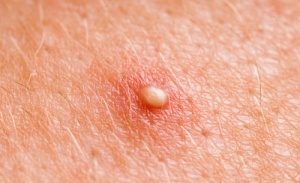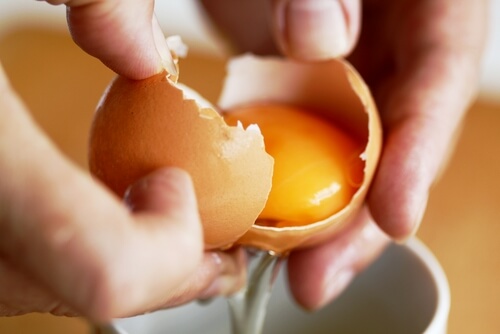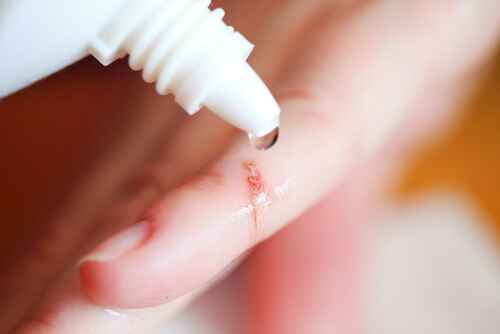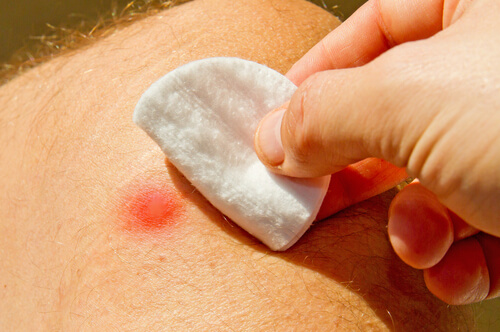Homemade Remedies that may Help With Boils


Written and verified by the nutritionist Eliana Delgado Villanueva
Boils are very common and can pop up on any part of your body, but the areas most commonly affected by these painful pimples are the armpits, buttocks, shoulders, groin and inner thigh. In this article, we’ll talk about some homemade remedies that may help with boils.
What causes boils to form?
These lesions first appear as insignificant red dots that are slightly painful. However, as time goes by, the pain can intensify quite a bit, and the pimple can grow to a much bigger size due to swelling.
Boils are the result of a bacterial infection (especially Staphylococcus aureus), although this isn’t the only reason why boils form. There are other reasons, such as:
- Blood poisoning
- Diabetes
- Poor hygiene
- Poor diet
Natural remedies that may help with boils

- Place a bit of the membrane found inside eggshells on the affected area.
- Make a paste out of raw, grated carrot mixed with a bit of wheat germ. Apply the mixture directly to the boil and cover it with a clean cloth.
- Apply hot water compresses with a clean cloth. This should be done at least three times per day. Once the boil pops, you should continue with this treatment so that all of the pus inside the pimple can be removed.
- Mix one tablespoon of honey with one tablespoon of brewer’s yeast and one of wheat flour. Stir the mixture to form a smooth cream and apply this to the affected area. Cover it with a cloth and allow it to set all night.
- Do you suffer from this problem regularly? If so, boil 80 grams of nettle in one liter of water and drink this in three equal portions throughout the day. This infusion will purify your organism and cleanse your blood.
Read also:
6 Healthy Drinks That Will Cleanse Your Blood
Further recommendations
Don’t pop that boil!
A boil is a delicate lesion, so you shouldn’t put any pressure on it. Doing so could be dangerous, allowing bacteria to invade the bloodstream and infect other parts of your body (sepsis). When you get a boil on your lips or nose, it can be very risky to pop it, because the infection could even reach your brain (meningitis).
The affected area must remain very clean

When you clean a boil, you must use appropriate gloves. But most importantly, you should wash your hands very well after cleaning the area and before preparing food so that you can avoid intoxicating others.
Read also:
Warning signs to head straight to the doctor

If you’re treating a boil and start to experience the following symptoms, you should go to the doctor as soon as possible. These are clear signs that the infection is spreading:
- There’s a large red area around the boil.
- The lymph nodes close to the boil are somewhat painful.
- A red line that goes out of the affected area appears near the boil.
Remember…
Having a boil isn’t a serious problem, but you can take certain precautions to make sure that this condition doesn’t spread, worsen or turn into an infection that could require more specialized treatments.
We hope you’ve enjoyed this article on remedies that may help with boils!
All cited sources were thoroughly reviewed by our team to ensure their quality, reliability, currency, and validity. The bibliography of this article was considered reliable and of academic or scientific accuracy.
- Altıparmak, M., Kule, M., Öztürk, Y., Yaşar Çelik, S., Öztürk, M., Duru, M. E., & Koçer, U. (2019). Skin wound healing properties of Hypericum perforatum, Liquidambar orientalis, and propolis mixtures. European Journal of Plastic Surgery, 42, 489-494. https://link.springer.com/article/10.1007/s00238-019-01538-6
- Antonescu, A. I., Miere, F., Fritea, L., Ganea, M., Zdrinca, M., Dobjanschi, L., Antonescu, A., Vicas, S. I., Bodog, F., Sindhu, R. K., Cavalu, S. (2021). Perspectives on the Combined Effects of Ocimum basilicum and Trifolium pratense Extracts in Terms of Phytochemical Profile and Pharmacological Effects. Plants, 10(7), 1390. https://www.mdpi.com/2223-7747/10/7/1390
- Ashwlayan, K. A., & Verma, M. (2018). Therapeutic potential of Calendula officinalis. Pharmacy & Pharmacology International Journal, 6(2), 149-155. https://medcraveonline.com/PPIJ/therapeutic-potential-of-calendula-officinalis.html
- Chakraborty, A. (2023). Bathing Practices in Dermatology: Uses and Implications for Patient Management. Indian Dermatology Online Journal 14(5), 686-691. https://journals.lww.com/idoj/fulltext/2023/14050/bathing_practices_in_dermatology__uses_and.19.aspx
- Chakraborty, A. J., Uddin, T. M., Matin Zidan, B. M. R., Mitra, S., Das, R., Nainu, F., Dhama, K., Roy, A., Hossain, M. J., Khusro, A., & Emran, T. B. (2022). Allium cepa: A Treasure of Bioactive Phytochemicals with Prospective Health Benefits. Evidence Based Complementary and Alternative Medicine, 2022, 4586318. https://pmc.ncbi.nlm.nih.gov/articles/PMC8789449/
- Göç, F., Erel, E., & Sarı, A. (2021). Plants used in traditional treatment for boils in Turkey. International Journal of Traditional and Complementary Medicine Research, 2(1), 49-61. https://dergipark.org.tr/en/pub/ijtcmr/issue/61352/851935
- Ibler, K. S., & Kromann, C. B. (2014). Recurrent furunculosis – challenges and management: a review. Clinical, Cosmetic and Investigational Dermatology, 7, 59-64. https://www.dovepress.com/recurrent-furunculosis-ndash-challenges-and-management-a-review-peer-reviewed-fulltext-article-CCID
- InformedHealth.org [Internet]. (22 de noviembre de 2022). Boils and carbuncles. Institute for Quality and Efficiency in Health Care (IQWiG). https://www.ncbi.nlm.nih.gov/books/NBK513141/
- InformedHealth.org [Internet]. (22 de noviembre de 2022). Boils and carbuncles: Learn More – How are boils treated? Institute for Quality and Efficiency in Health Care (IQWiG). https://www.ncbi.nlm.nih.gov/books/NBK513136/
- Labban, L. (2014). Medicinal and pharmacological properties of Turmeric (Curcuma longa): A review.
International Journal of Pharmaceutical and Bio Medical Science, 5(1), 17-23. https://www.researchgate.net/publication/262005934_Medicinal_and_pharmacological_properties_of_Turmeric_Curcuma_longa_A_review - National Health Service. (20 de junio de 2023). Boils. https://www.nhs.uk/conditions/boils/
- Patel, D. K. (2014). Some traditional medicinal plants useful for boil, burn and for wounds healing. Journal of Biodiversity & Endangered Species, 2(133), 2. https://www.researchgate.net/publication/273191969_Some_Traditional_Medicinal_Plants_Useful_for_Boil_Burn_and_for_Wounds_Healing
- Polito, L., Bortolotti, M., Battelli, M. G., Calafato, G., & Bolognesi, A. (2019). Ricin: An Ancient Story for a Timeless Plant Toxin. Toxins, 11(6), 324. https://pmc.ncbi.nlm.nih.gov/articles/PMC6628454/#sec6-toxins-11-00324
- Reddy, I. V. S., & Neelima, P. (2022). Neem (Azadirachta indica): A Review on Medicinal Kalpavriksha. International Journal of Economic Plants, 9(Feb, 1), 059-063. https://www.ojs.pphouse.org/index.php/IJEP/article/view/4713
- Sabir, S., Arshad, M., Zahara, K., Tabassum, S., & Chaudhari, S. K. (2014). Pharmacological attributes and nutritional benefits of tea tree oil. International Journal of Biosciences, 5, 80-91. https://www.researchgate.net/publication/279178729_Pharmacological_attributes_and_nutritional_benefits_of_tea_tree_oil_International_Journal_of_Biosciences_IJB
- Thakur, S., Kaurav, H., & Chaudhary, G. (2021). Nigella sativa (Kalonji): A black seed of miracle. International Journal of Research and Review, 8(4), 342-357. https://www.ijrrjournal.com/IJRR_Vol.8_Issue.4_April2021/IJRR-Abstract041.html
This text is provided for informational purposes only and does not replace consultation with a professional. If in doubt, consult your specialist.








